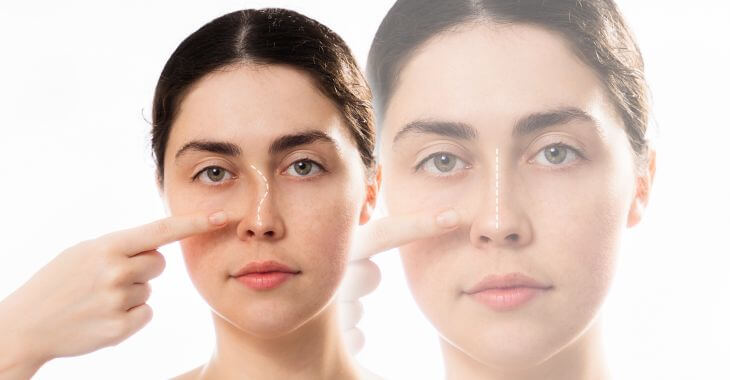What Is Ultrasonic Rhinoplasty?

Ultrasonic rhinoplasty is a cutting-edge surgical technique used to reshape and refine nasal structures with the assistance of ultrasonic energy. This innovative approach has revolutionized the field of rhinoplasty, offering surgeons greater precision in achieving desired outcomes for patients.
Differences Between Traditional and Ultrasonic Nose Jobs
Rhinoplasty, commonly referred to as a “nose job,” is a surgical procedure designed to reshape the nose for cosmetic or functional purposes. Traditional rhinoplasty techniques involve manual bone cutting and sculpting using surgical instruments such as scalpels and osteotomes.
In comparison, ultrasonic rhinoplasty employs ultrasonic energy to precisely sculpt and shape the nasal bones, cartilage, and soft tissues with unparalleled accuracy. Ultrasonic rhinoplasty is also known as ultrasonic-assisted rhinoplasty, ultrasonic nose job or ultrasonic bone sculpting rhinoplasty.
What to Expect with Ultrasonic Rhinoplasty
The ultrasonic rhinoplasty procedure begins with a thorough consultation between the patient and their plastic surgeon to discuss goals, expectations and surgical options. During the consultation, the surgeon evaluates the patient’s nasal anatomy, aesthetic concerns, and functional issues.
After the exam and consultation with the patient, the plastic surgeon can develop a customized treatment plan tailored to the patient’s unique needs.
On the day of the surgery, the patient is placed under general anesthesia or local anesthesia with sedation, depending on the extent of the procedure and the preferences of the surgeon and patient. Once the patient is comfortably sedated, the surgeon begins the ultrasonic rhinoplasty procedure.
The first step in ultrasonic rhinoplasty is to create precise incisions in the nasal tissues to access the underlying structures. These incisions are typically made inside the nostrils (endonasal approach) or across the columella (open approach), depending on the complexity or purpose of the surgery.
Once the nasal structures are exposed, the surgeon utilizes specialized ultrasonic instruments, such as ultrasonic bone sculpting devices, to precisely reshape and refine the nasal bones and cartilage with less chance of irregularities.
Benefits of Ultrasonic Rhinoplasty
Unlike traditional techniques that rely on manual force and mechanical instruments, ultrasonic rhinoplasty allows surgeons to sculpt the nasal structures with greater accuracy and finesse, minimizing trauma to the surrounding tissues. Some of the benefits include:
- Lessened Risk of Complications: The precision of ultrasonic sculpting can reduce the risk of complications such as fractures.
- Targeted Tissue Sculpting: The ultrasonic energy emitted by the specialized instruments selectively targets and breaks down the bone and cartilage while sparing the surrounding soft tissues, nerves and blood vessels.
- Precise Nasal Reshaping: The ultrasonic approach enables surgeons to achieve precise and controlled bone sculpting, allowing for more predictable and consistent results compared to traditional rhinoplasty techniques.
- Versatility: One of the key advantages of ultrasonic rhinoplasty is its ability to address a wide range of nasal concerns with greater precision and versatility. It can be used for the reduction of a dorsal hump, nasal tip refinement, correction of asymmetry, or improvement in nasal airflow.
- Extreme accuracy: The ultrasonic technique allows surgeons to achieve the desired aesthetic and functional outcomes with exceptional accuracy.
Furthermore, ultrasonic rhinoplasty offers several benefits for both surgeons and patients. For surgeons, the technology provides enhanced visibility, control, and efficiency during the procedure, leading to shorter operative times, reduced surgical trauma and improved surgical outcomes.
Patients benefit from minimized postoperative discomfort, faster recovery times, and natural-looking results with less bruising and swelling compared to traditional rhinoplasty techniques.
Is Ultrasonic Rhinoplasty Right for You?
It is important to note that ultrasonic rhinoplasty is not suitable for every patient or every nasal anatomy. The technique requires specialized training, expertise and experience to perform safely and effectively. Certain nasal deformities may be better addressed with traditional surgical techniques.
Traditional rhinoplasty, which involves manual bone cutting and sculpting using surgical instruments such as scalpels and osteotomes, may be more suitable for addressing certain nose deformities.
On the other hand, ultrasonic rhinoplasty, which utilizes specialized ultrasonic instruments to sculpt and shape the nasal bones and cartilage with precision, may be better suited for addressing the following nose deformities:
- Thick or Dense Bones: Ultrasonic rhinoplasty is particularly effective for patients with thick or dense nasal bones, as the ultrasonic energy can easily penetrate and sculpt the bone without causing excessive trauma to the surrounding tissues.
- Narrowing the Nasal Bones: Ultrasonic rhinoplasty can achieve precise and controlled narrowing of the nasal bones, allowing surgeons to achieve a more refined and balanced nasal appearance.
- Revision Rhinoplasty: Patients who require revision rhinoplasty, or secondary rhinoplasty, may benefit from ultrasonic techniques, as the technology allows for more precise and targeted bone sculpting in areas that have already been operated on.
- Reducing the Risk of Fractures: Ultrasonic rhinoplasty is associated with a lower risk of bone fractures and irregularities compared to traditional techniques, making it an excellent option for patients seeking a safer and more predictable outcome.
Ultrasonic rhinoplasty represents a significant advancement in the field of nasal surgery, offering surgeons and patients a safe, precise and versatile approach to nasal reshaping and refinement. Ultrasonic rhinoplasty has become popular for individuals seeking a nose job.

As technology continues to evolve, the future of rhinoplasty holds promise for further advancements and refinements in surgical techniques, such as ultrasonic nose jobs, ultimately benefiting patients seeking optimal outcomes in nasal aesthetics and function.
The information provided on this website, including text, graphics, images, and other materials, is intended solely for informational purposes and should not be used as a substitute for professional medical advice, diagnosis, or treatment.



)